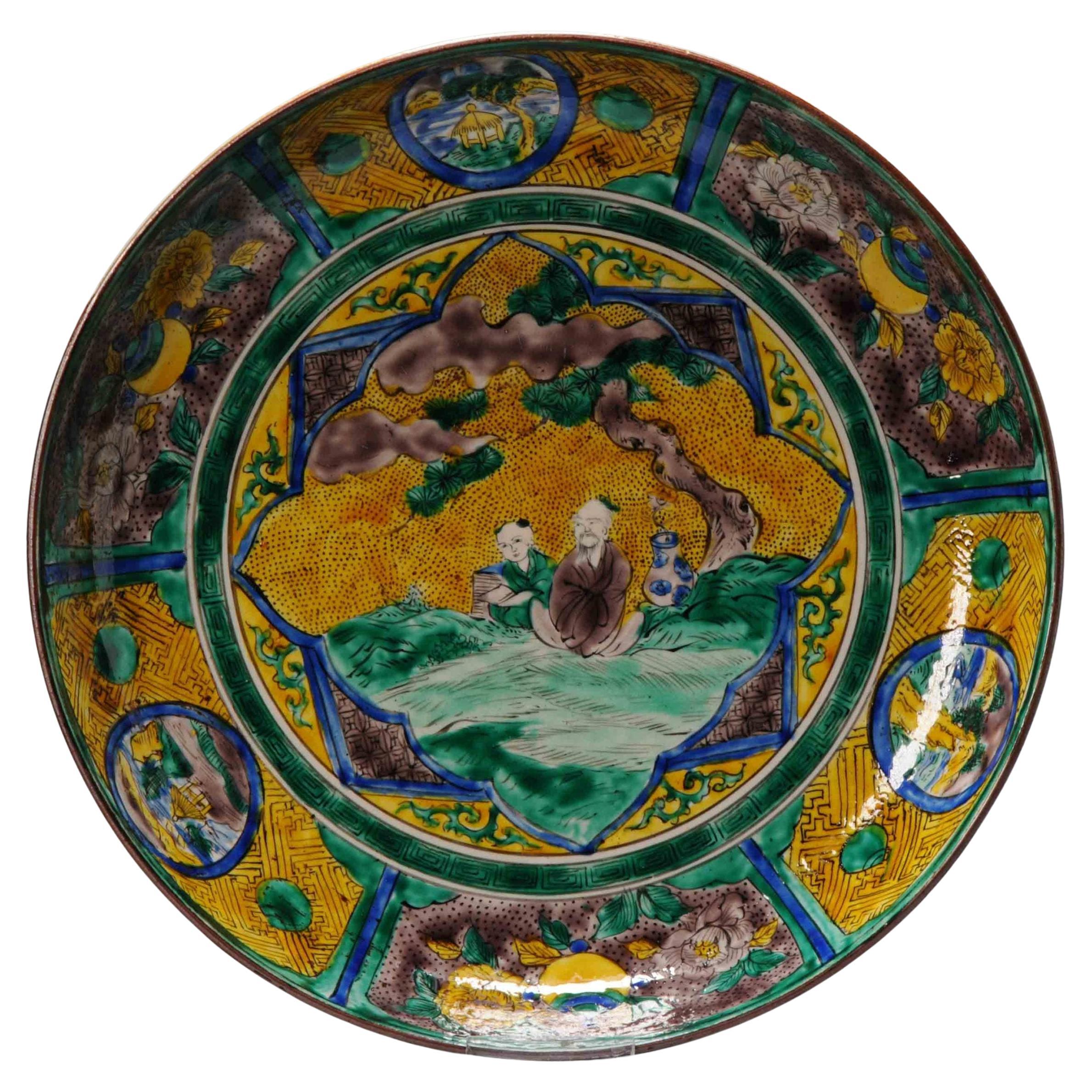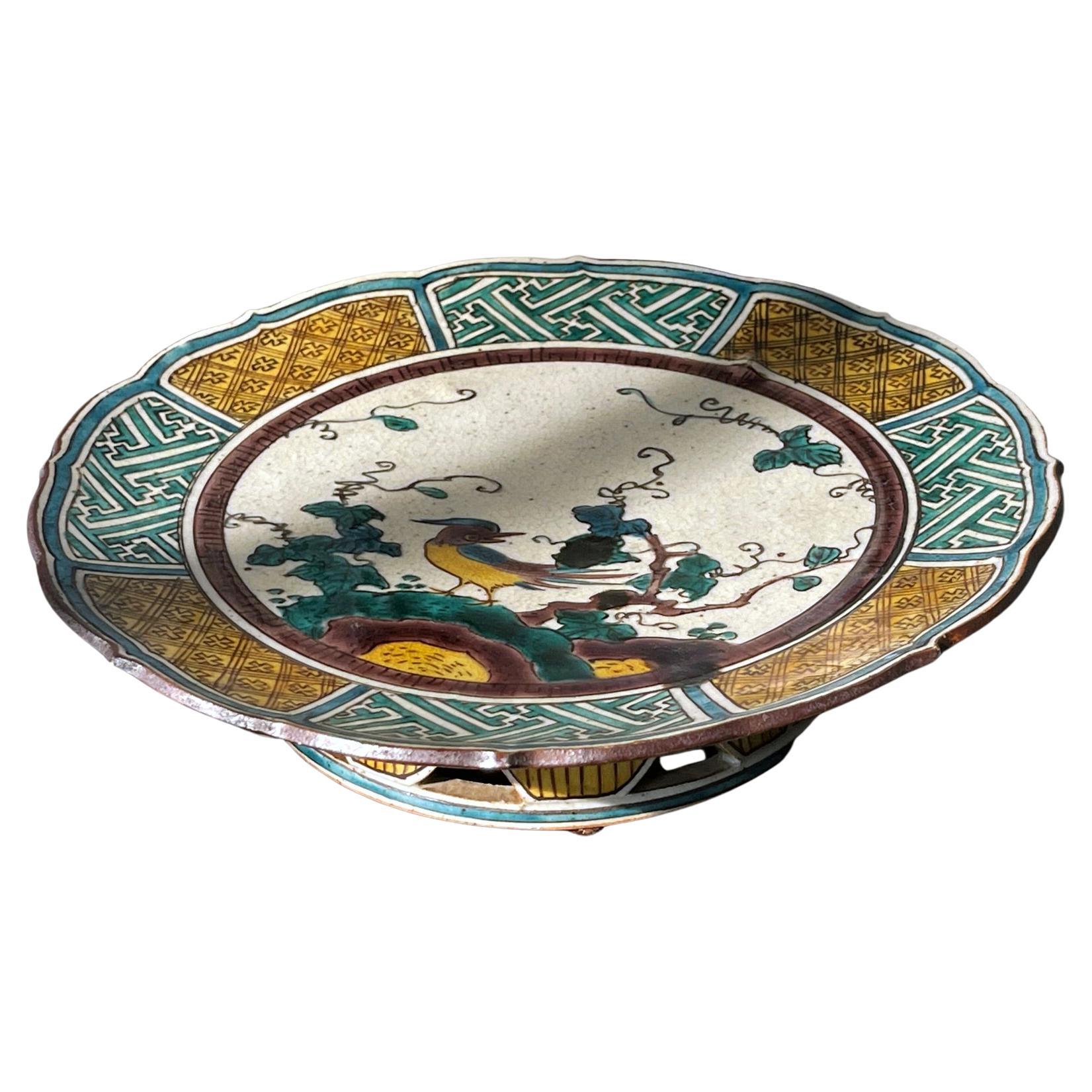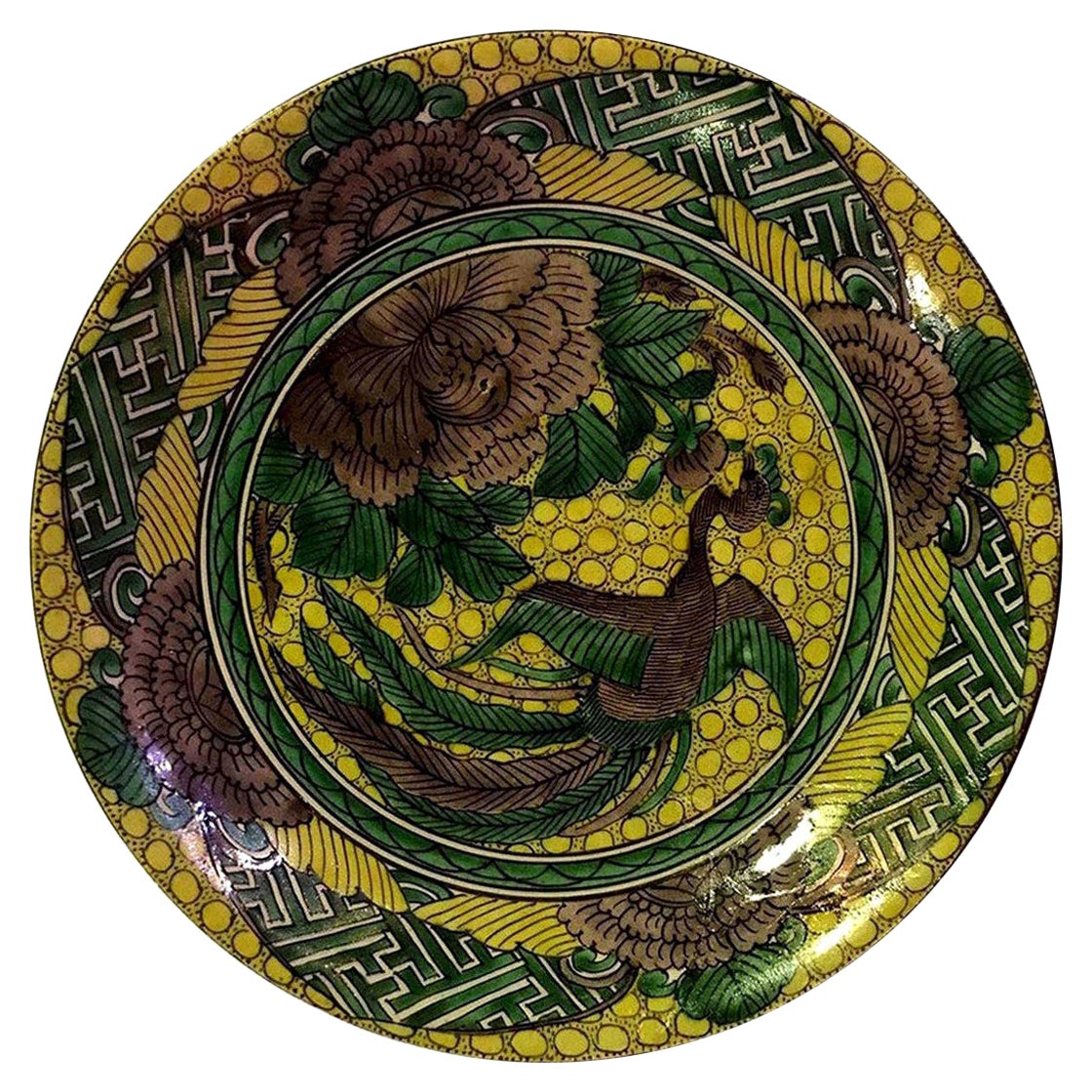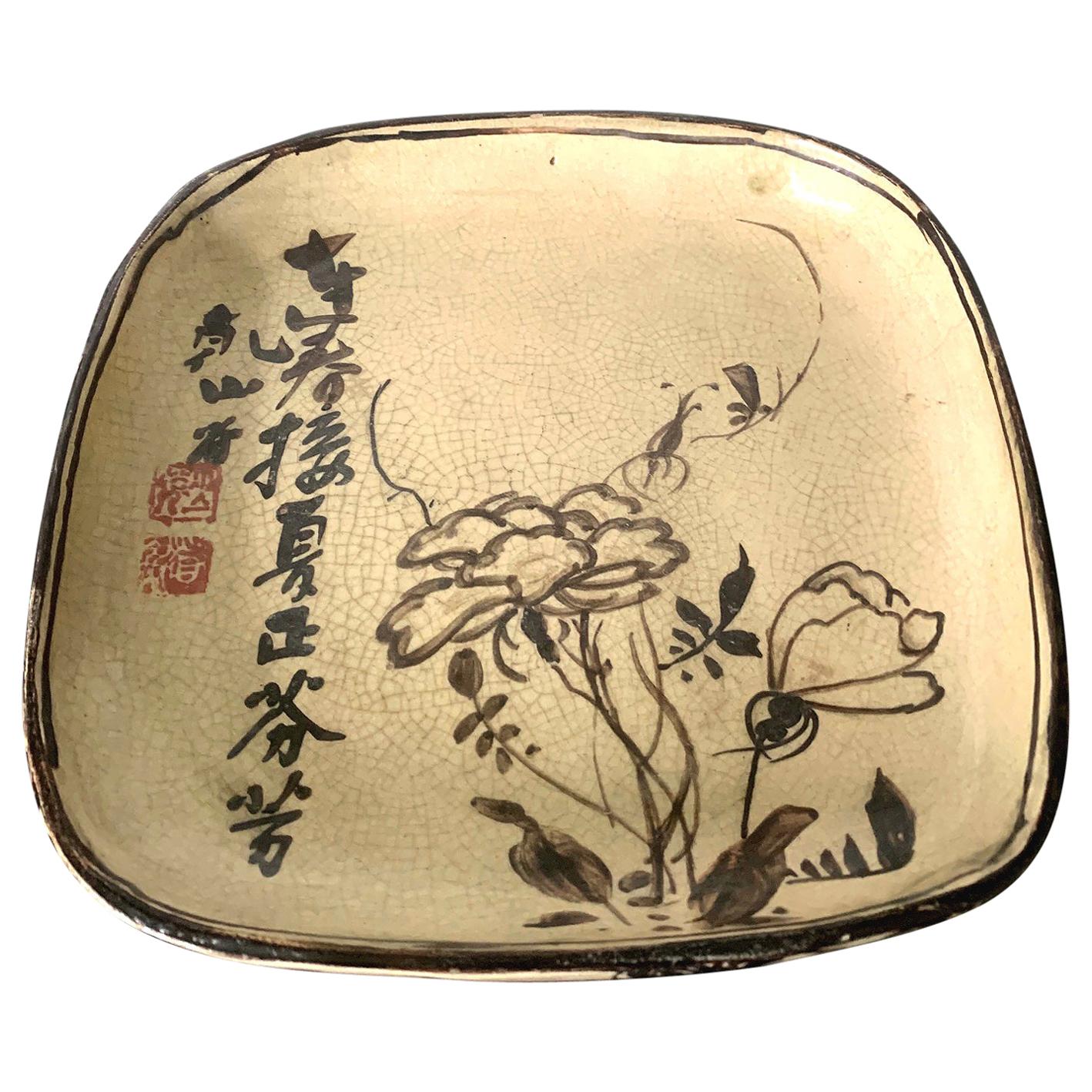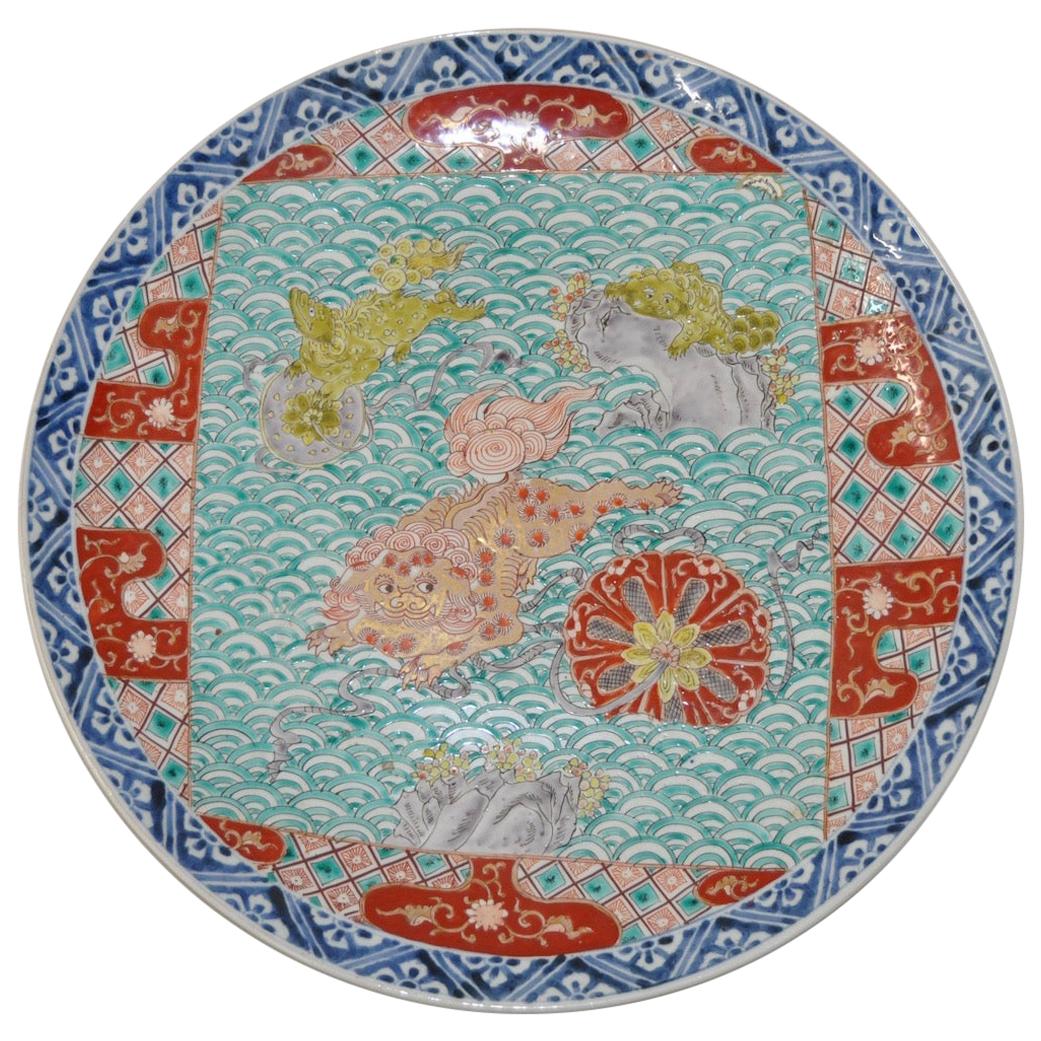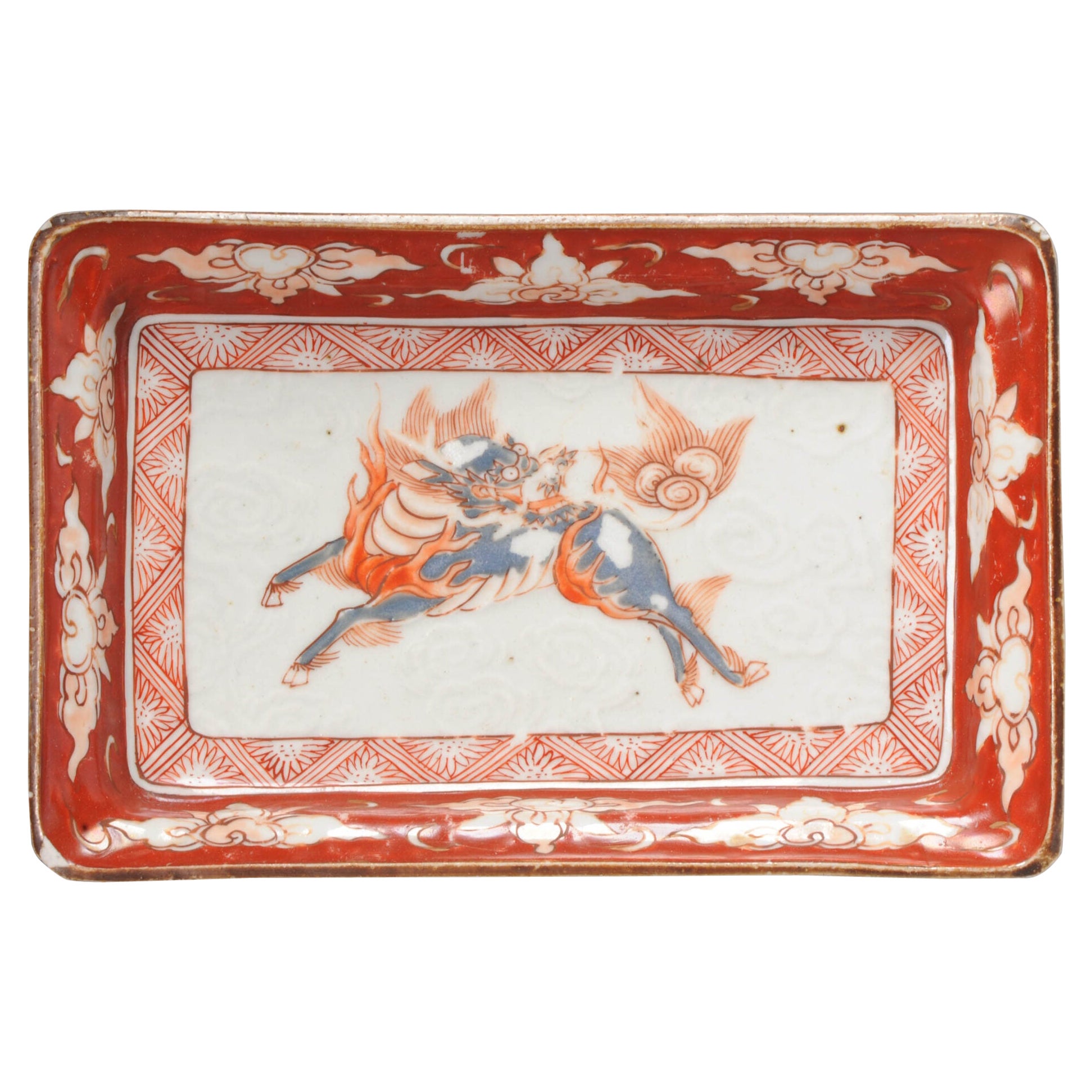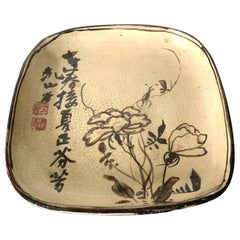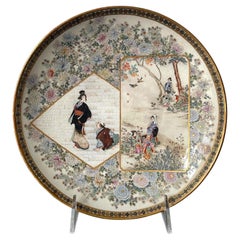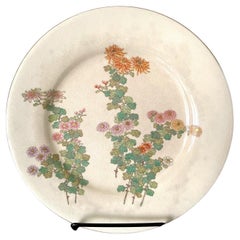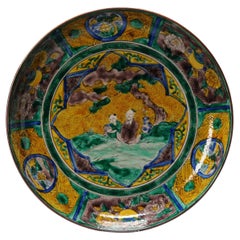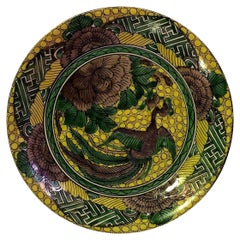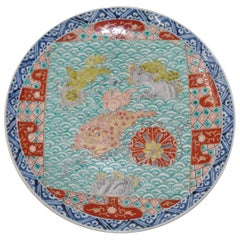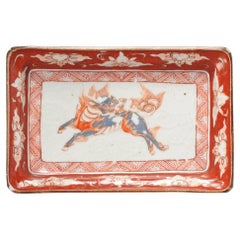Items Similar to Japanese Yoshidaya Saiko Kutani Ceramic Dish
Want more images or videos?
Request additional images or videos from the seller
1 of 11
Japanese Yoshidaya Saiko Kutani Ceramic Dish
$8,800
£6,677.24
€7,634.82
CA$12,291.21
A$13,666.16
CHF 7,135.71
MX$166,350.41
NOK 91,048.59
SEK 85,308.18
DKK 56,980.10
Shipping
Retrieving quote...The 1stDibs Promise:
Authenticity Guarantee,
Money-Back Guarantee,
24-Hour Cancellation
About the Item
A Japanese Ao-Kutani stoneware dish with overglaze decoration in the shape of barbed quatrefoil shape from late Edo period, circa early mid-19th century. Around 1804, 100 years after Ko-Kutani (old-Kutani) ware disappeared abruptly after thriving from 1655-early 1700s, saiko-kutani (revived-kutani) was attempted by many kilns and several distinguished styles developed. Among them, Yoshidaya kiln attempted to revive the original style of Ko-Kutani known as Aote, which employed four dark colors: green, yellow, dark blue/black and aubergine to create bold and striking design. The Yoshidaya production was short-lived and lasted roughly from 1823-1831. This dish is likely dated from this period or shortly after. The overglaze design centered around a crouching tiger under a black bamboo grove in a deep green background, surrounded by luxuriant banana leaves in green and aubergine with black outlines. The base of a similar concentric barbed quatrefoil design is further decorated with black foliage outlines and marked with a square Fuku mark.
For a Yoshidaya dish with identical shape but different landscape decoration, see lot 79 of sale 6547 Christie's London. Important Japanese and Chinese Art from the Manno Art Musuem. 21st June 2001
Historical background:
Yoshidaya is the professional name of Toyota Denuemon IV, AKA Sekio (1751-1827), a wealthy merchant living in Daishoji who Invested in kiln to make Ko-Kutani wares. Initially, he built a kiln Yoshidaya next to the Old Kutani kiln at his own cost to Revive Aote ware. The production was very close to Ko-Kutani in the artistry and quality, which were acclaimed by the wealthy class and intellectuals of the day. But his efforts of pursuing the ultimate quality with a disregard for profit put the business in a predicament. He then moved the kiln to the Yamashiro area, which was much easier to access, to restore the financial situation. Despite this, 7 years later in 1831 the business was forced to close down. The closure of Yoshidaya kiln deteriorated the production of Aote Kutani, but it flourished once again in the “Matsuyama kiln” made by the Daishoji clan. The Matuyama kiln worked on the production of Aote Kutani ware till the abolition of the feudal system by the Meiji government in 1868.
- Creator:Yoshidaya (Maker)
- Dimensions:Height: 2 in (5.08 cm)Width: 11 in (27.94 cm)Depth: 11 in (27.94 cm)
- Style:Japonisme (Of the Period)
- Materials and Techniques:
- Place of Origin:
- Period:
- Date of Manufacture:First Half of the 19th Century
- Condition:Wear consistent with age and use. Fine with minor surface wear and patina, a couple of minute kiln imperfection on the surface.
- Seller Location:Atlanta, GA
- Reference Number:1stDibs: LU945015745512
About the Seller
4.9
Platinum Seller
Premium sellers with a 4.7+ rating and 24-hour response times
Established in 2006
1stDibs seller since 2010
564 sales on 1stDibs
Typical response time: <1 hour
- ShippingRetrieving quote...Shipping from: Atlanta, GA
- Return Policy
Authenticity Guarantee
In the unlikely event there’s an issue with an item’s authenticity, contact us within 1 year for a full refund. DetailsMoney-Back Guarantee
If your item is not as described, is damaged in transit, or does not arrive, contact us within 7 days for a full refund. Details24-Hour Cancellation
You have a 24-hour grace period in which to reconsider your purchase, with no questions asked.Vetted Professional Sellers
Our world-class sellers must adhere to strict standards for service and quality, maintaining the integrity of our listings.Price-Match Guarantee
If you find that a seller listed the same item for a lower price elsewhere, we’ll match it.Trusted Global Delivery
Our best-in-class carrier network provides specialized shipping options worldwide, including custom delivery.More From This Seller
View AllAntique Japanese Ceramic Ko-Kutani Revival Footed Dish
Located in Atlanta, GA
A Japanese glazed ceramic footed dish made in the Ko-Kutani type of Edo period but likely during Kutani revival in the 19th century Meiji Period. The dish with delicate foliaged rim ...
Category
Antique 19th Century Japanese Japonisme Ceramics
Materials
Ceramic
Japanese Ceramic Dish Meiji Ogata Kenzan
Located in Atlanta, GA
A Japanese ceramic shallow dish in square form with rounded corners from Meiji period in the style of Ogata Kenzan. The dish features a cream color crackl...
Category
Antique 19th Century Japanese Meiji Ceramics
Materials
Ceramic
Japanese Satsuma Ceramic Dish with Fine Decoration by Kinkozan
By Kinkozan
Located in Atlanta, GA
A satsuma ceramic dish made by Kinkozan studio circa 1980-1900s in the late Meiji Period. The dish with a thick robust wall is supported by a large ring base and features finely deta...
Category
Antique Late 19th Century Japanese Meiji Ceramics
Materials
Ceramic
Fine Japanese Ceramic Plate by Kinkozan for Yamanaka & Co.
By Kinkozan
Located in Atlanta, GA
A fine Japanese ceramic satsuma plate made by Kinkozan and retailed by Yamanaka & Co. circa 1900-20s (late Meiji to early Tasho Period). The cream-color...
Category
Early 20th Century Japanese Meiji Ceramics
Materials
Ceramic
Japanese Antique Kakiemon Plate from Arita
Located in Atlanta, GA
A milky white dish with slight scalloped rim and decorated with cobalt blue iron red and green enamel over glaze, this delicate piece in Kakiemon Style was dated at least to the earl...
Category
Antique Early 18th Century Japanese Japonisme Ceramics
Materials
Porcelain
Rare Japanese Ceramic Glazed Bowl Makuzu Kozan Meiji Period
By Makuzu Kozan
Located in Atlanta, GA
On offer is a rare ceramic bowl with overglazed design by the famed Japanese ceramic artist Makuzu Kozan (1842-1916), circa 1906-1916. The bowl is rather unusual from the potter's repertoire with its unique glaze colors and decoration, and it likely belonged to a small series that Kozan made in and after 1906. A bowl of similar glaze and nearly identical dragon motif was recorded as a diplomatic present to the British royalty Arthur Connaught (1883-1932) when he represented King Gorge V in Japan in 1906. Other pieces, such as this bowl, were likely made with similar materials and designs afterwards.
Essentially round in form, the bowl has a generous volume with six harmonious lobes. The bottom of the interior showcases a coiled dragon in red, green and gold slithering on a cobalt blue background. The roundel shares an echoing lobed perimeter, which is further outlined by red and turquois bands and rising sun design. The exterior of the bowl features six stylized Japanese camellias...
Category
Antique Early 1900s Japanese Japonisme Ceramics
Materials
Ceramic
You May Also Like
Antique 19th Century Japanese Porcelain Yoshidaya Kutani Large Dish, Japan
Located in Amsterdam, Noord Holland
Sharing with you this lovely and unusal Kutani porcelain large dish. The dish is of circular form and has a scene of a wise man and his apprentice in a landscape scene. With beautiful colors and very nicely painted.
Base marked with a Fuku mark...
Category
Antique 19th Century Japanese Qing Ceramics
Materials
Porcelain
$4,700 Sale Price
20% Off
Japanese Signed Polychrome Ceramic Pottery Plate, Showa Period
Located in Studio City, CA
A wonderfully decorated, hand painted Japanese plate.
From a collection of Japanese art, pottery, and artifacts.
Signed or stamped o...
Category
Mid-20th Century Japanese Showa Ceramics
Materials
Ceramic
Antique Chinese Enameled Ceramic Platter, 19th Century
Located in San Francisco, CA
19th century Chinese enameled ceramic platter.
Beautifully hand painted with superb detail throughout.
Very good condition.
Dimensions 18" diameter x 2" high.
No chips. ...
Category
Antique Late 19th Century Chinese Chinese Export Ceramics
Materials
Ceramic
Antique Edo Period Japanese Porcelain Serving Dish ko-Kutani, ca 1660-80
Located in Amsterdam, Noord Holland
A very nice Ko-Kutani serving dish in red enamel with a central scene of a Foo dog or Lion. The ground has ajour decoration. Early piece.
Additional information:
Material: Porcelain...
Category
Antique 16th Century Japanese Serving Pieces
Materials
Porcelain
$1,998 Sale Price
20% Off
Antique Serving Bowl, English, Ceramic, Fruit Dish, Oriental Taste, Circa 1920
Located in Hele, Devon, GB
This is an antique serving bowl, an English ceramic fruit dish with Oriental taste, dating to the early 20th century, circa 1920. With dazzling colour and striking dragon motif, this...
Category
Vintage 1920s British Chinese Export Decorative Bowls
Materials
Ceramic
Chinese Ceramic Plate, Late 19th Century
Located in Roma, IT
Chinese ceramic plate, China late 19th century.
Iron hook on the back
Plate diameter 22 cm.
Good conditions except for a minor loss on ...
Category
Antique Late 19th Century Chinese Porcelain
Materials
Ceramic
$251 Sale Price
30% Off
More Ways To Browse
Kiln Japanese
Used Ceramic Kilns
Japanese Antique Marks
19th Century Japanese Ceramic
Green Ceramic Dish
Japanese Tiger
Antique Kutani
Chinese Green And Black Ceramic
Kutani Meiji
Antique Japanese Stoneware
Tiger Bamboo
Antique Banana
Ceramic Tiger
Meiji Tiger
Japanese Kutani Ware
Kutani Ware
Antique Kutani Marks
Kutani China
